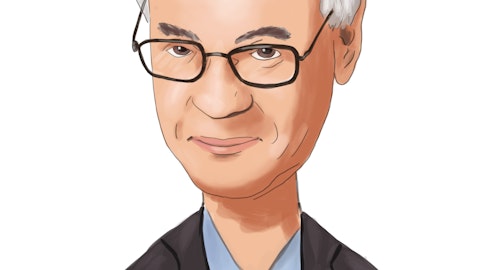Bill Burns: Yes. I think I understand what you’re saying. So a lot of our — we have federal home loan borrowings that are actually term and we also have some that are overnight that are hedged. And so we locked in a lot of borrowings at a lower rate. And so, when the short term paid off, that caused the rate to go down for the quarter.
Daniel Tamayo: So, how does that — I mean is it — does the hedge just play through next year then so that you won’t see too much increase in cost there?
Bill Burns: Yes. They continue to immunize us against the rates — higher rates. And so like I said, we extend the duration of that portfolio and that has helped us.
Operator: Your next question comes from the line of Frank Schiraldi of Piper Sandler.
Frank Schiraldi: Just a follow-up on the margin. Bill, your comments on NIM inflection, I thought — in terms of a higher for longer rate scenario, so rates just basically stay where they are. In your thinking, do deposit balances for the industry, for CNOB, do they begin to stabilize in the next quarter or two, or do you think there’s a continued trickle up, which is why you wouldn’t necessarily get inflection and then a trajectory upwards in the name in 2024?
Bill Burns: You’re saying trickle up in terms of rate?
Frank Schiraldi: Yes.
Bill Burns: Yes. I would say that that’s exactly it. So, our time deposits are very close to leveling out in terms of the costs, but there continues to be pressure on the non-maturity interest bearing accounts. And so, that’s why I’ve been conservative about the margin. We have assets repricing, but it’s a small amount and it’s worth a few basis points a quarter of widening. But that continued pressure of interest rates increasing on those non-maturity deposits causes me to believe that there could still be compression.
Frank Schiraldi: And then just thinking about the buyback here, given maybe a bit slower growth in this environment. Do you think it’s a reasonable level what you guys did in the quarter? Is that a reasonable bogey to think about going forward on a quarterly basis or do you think — do you look to get more aggressive? What are your just general thoughts on the…
Bill Burns: I think that’s the maximum that we would want to be. We’re looking at growth. And also, I just feel, in this environment, even though we have strong capital, it’s good to show that we continue to build capital. I don’t know how you feel about it, but everyone is concerned about bank balance sheets and liquidity, and I think continuing to show strong numbers and strengthening it, while still growing a little bit and buying back is the best way to look at those three items. We’ll watch the numbers. To the extent we have more ability to buy back stock, we will because I like buying stock back below tangible book value per share.
Frank Schiraldi: And then lastly, just obviously, you guys have some pretty good insight into the commercial real estate market in and around New York. Just wondered if — curious your thoughts, particularly, as it pertains to multifamily here. You have some that talk about multifamily as being a dangerous place to be in New York in this environment, and others who sort of continue to look at it as this fortress balance sheet that’s had these best-in-class returns in terms of risk adjusted returns over the last 20, 30, 40 years. So, just curious your thoughts as it pertains to multifamily at ConnectOne but also in general in the geography.
Frank Sorrentino: So, you got the New York City and the five boroughs and then you have the suburbs, which would include Long Island and New Jersey where the vast majority of our portfolio exists. And I will tell you that in both of — what’s similar about both of those markets is there is just not enough supply. The demand is outstripping the supply. And even today, rental rates continue to march higher. I think that’s even more pronounced than New York City market. Market rate rents continue to move northward. I think in New Jersey, the newer product is still renting very quickly. We’re not hearing about any buildings that have vacancies. New construction that we finance, the minute it’s completed, it’s completely filled at record time.
So, there’s definitely large demand for that because we’re undersupplied. And so, people have gotten raises, everybody has a job. I think the dynamics around the multifamily business are actually quite good right now, and for the foreseeable future, I think they remain good. The anomaly there though is the rent stabilized product in New York City that was negatively impacted by the changes in the law in 2019. Some of those properties are challenged. And so, when those come up on a refinance and a repricing, there are issues there. And in cases where folks lent on a pro forma rent projection based on that change in going from rent stabilized to market, and that’s not available anymore, and now the interest rate went up, there could be some losses in those portfolios.
So, I think underwriting is important, the type of product, where it is, what it represents is important, that entire bucket of rent stabilized. I’m not saying it’s all bad. There are lots of good properties in there that cash flow well and can in fact withstand the rate increases. And they may be closer to 100% loan to value, but that’s okay if they can afford to maintain their mortgage payments. So, overall, I wouldn’t call it bullish, but I would tell you that we’re definitely quite confident and comfortable in our portfolio with CNOB, and I would say for the vast majority of the portfolios that I’m aware of across the industry.
Operator: Your next question comes from the line of Matthew Breese of Stephens.
Matthew Breese: Bill, maybe the first one for you. I was hoping you could provide just sort of your near-term net interest margin outlook, feels like it’s slightly lower, but to what extent? And then where do you think we might see stability as we look out the next several quarters? Either what quarter or at what level?
Frank Sorrentino: I’ll get those crystal balls.
Bill Burns: I knew you were going to ask that, Matt. Look, there’s a number of factors going on for the fourth quarter. And we’re only a month into it. So, it is difficult to give you exact numbers. What’s working for us, I think I said before, is that we’re basically pricing out on the time deposits and those have been about the same. The non-interest bearing demand fell more than I had thought, but it has leveled out for now. So, I’m not 100% sure about the level of those. We have loans that are going on the balance sheet at 300 basis points more than they’re coming off, but it’s a small amount. So with the continued competition on the non-maturity interest-bearing which still is starting — still floating up, I see some compression.




